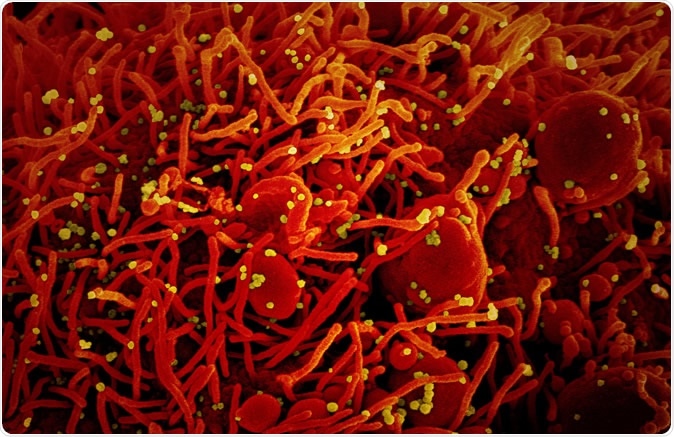A specific biophysical model for severe acute respiratory syndrome coronavirus 2 (SARS-CoV-2) shows how potential drugs inhibiting both viral transcription and translation would be particularly effective against coronavirus disease (COVID-19). The model was developed by University of Minnesota researchers and described in their recent publication available on the bioRxiv* preprint server.
As of May 25, 2020, the current COVID-19 pandemic caused by SARS-CoV-2 has resulted in more than 5.47 million confirmed cases and approximately 344,000 deaths globally. At the moment, there is no vaccine for the disease, and its development could take up to 18 months or more. Therefore, effective therapeutic interventions to minimize the spread and severity of SARS-CoV-2 are direly needed.

Novel Coronavirus SARS-CoV-2 Colorized scanning electron micrograph of an apoptotic cell (red) infected with SARS-COV-2 virus particles (yellow), isolated from a patient sample. Image captured at the NIAID Integrated Research Facility (IRF) in Fort Detrick, Maryland. Credit: NIAID

 *Important notice: bioRxiv publishes preliminary scientific reports that are not peer-reviewed and, therefore, should not be regarded as conclusive, guide clinical practice/health-related behavior, or treated as established information.
*Important notice: bioRxiv publishes preliminary scientific reports that are not peer-reviewed and, therefore, should not be regarded as conclusive, guide clinical practice/health-related behavior, or treated as established information.
Using biophysical modeling in the hunt for drug candidates
With more than a hundred distinct agents currently in clinical trials for COVID-19, even a two-drug combination has over ten thousand possible synergistic options that could be tried. This raises the question of how to narrow down the focus of clinical trials on single agents and combinations that will most likely be effective.
Due to their intrinsic ability to swiftly evolve, viruses are often attacked with combination treatments. And while a comprehensive experimental combinatorial analysis is cumbersome (or even impossible) due to resource and time constraints, something similar can be implemented in silico rather quickly.
This is where biophysical modeling comes into play, with the promise to guide the development of therapeutic interventions for SARS-CoV-2 rationally by identifying key model parameters for effective targeting. Such modeling can additionally be used to pick out combination therapies, predict the outcomes of clinical trials, stratify patients, but also discern potential sources of variable patient-to-patient outcomes.
A research group from the University of Minnesota in Minneapolis recently described a biophysical model for the SARS-CoV-2 viral cycle and identified both single and combination parameters with the highest sensitivity, revealing, in turn, the optimal targets for therapeutic intervention to effectively inhibit virus production.
SARS-informed model construction
The biophysical model of the SARS-CoV-2 life cycle used in this study was constructed based on the literature on the original SARS outbreak virus (SARS-CoV), and it entails processes underlying viral entry, genome transcription and translation, virion assembly, and finally virion release.
Since data pertinent to the viral cycle to SARS-CoV-2 are still limited, researchers primarily utilized experimental observations from SARS-CoV to inform relevant model parameters and assumptions. Due to a high degree of genetic similarity between these two viruses, this has not resulted in the loss of reproducibility.
To appraise the points of interest within the viral cycle, the authors performed a sensitivity analysis for individual model parameters but also for all possible pairwise parameter changes (i.e., 256 possible combinations). The values of each parameter were systematically increased and decreased from baseline by up to three orders of magnitude while holding all the other parameters constant.
"Based on this, we conclude that the model provides a suitable tool to identify points of interest for therapeutic intervention, i.e., those parameters and the associated subprocesses that are particularly sensitive to perturbation," state study authors in their paper available on bioRxiv.
Powerful cooperating effect
"Overall, our modeling of the SARS-CoV-2 life cycle, parametrized using published SARS-CoV literature, shows that theoretically there are opportunities for therapeutic interventions that significantly inhibit the viral cycle", study authors explain their main findings.
"In particular, the sensitivity analysis identified several parameters in the middle of the viral cycle, specific to genome transcription and translation, that present the best opportunities for inhibiting viral production," they add.
Interestingly, most of the high-scoring combinations did not merely arise as the result of targeting two high-sensitivity parameters separately but instead resulted from compounding/cooperating effects between them. In a nutshell, the model predicts that – everything else being equal – transcription inhibition combined with translation inhibition represents a uniquely powerful combination.
In comparison, parameters that are specific for viral entry, as well as virion assembly and release, were less sensitive and thus less promising as potential targets for inhibiting viral production. More specifically, they required a 10-100 times higher level of inhibition to influence viral production.
Additionally, the researchers noted that therapeutics forecasted to be much less effective in the viral cycle model might actually exhibit strong effects elsewhere in disease progression (e.g., the immune response). Hence, incapability to inhibit viral production does not rule out the compound's overall treatment effectiveness.
All things considered, this model provides a useful framework for understanding the dynamics of the SARS-CoV-2 viral cycle and recognizing treatment opportunities that have the most significant potential of inhibiting the production of viable viral particles. This is yet another breakthrough in the ongoing quest for effective drugs or vaccines against COVID-19.

 *Important notice: bioRxiv publishes preliminary scientific reports that are not peer-reviewed and, therefore, should not be regarded as conclusive, guide clinical practice/health-related behavior, or treated as established information.
*Important notice: bioRxiv publishes preliminary scientific reports that are not peer-reviewed and, therefore, should not be regarded as conclusive, guide clinical practice/health-related behavior, or treated as established information.